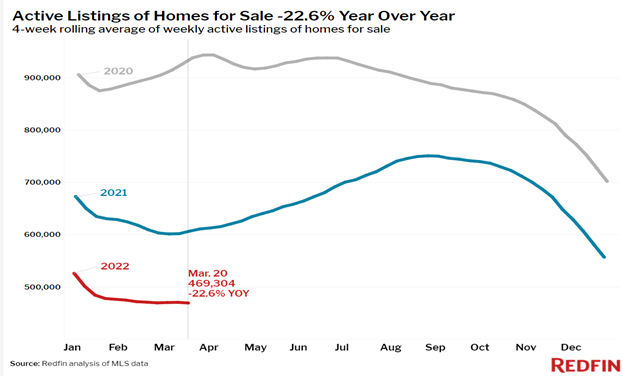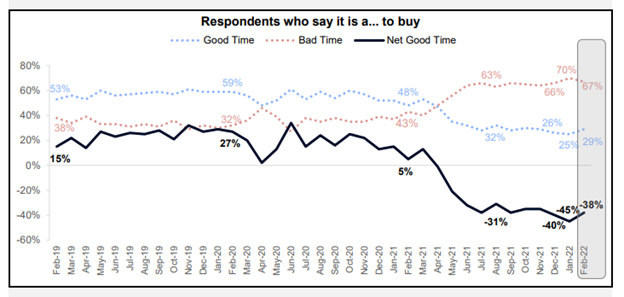Ups and Downs of Housing
Telemus Weekly Market Review March 21st - March 25th, 2022
This week the National Association of Realtors released pending home sales data that showed the number of homes under contract declined by -4.1% from February; a month after pending sales had declined -5.7% from January. After an incredibly hot housing market in 2021 where values increased nearly 19% nationwide, we are starting to see indications that conditions may be starting to cool.
In 2021 price gains were fueled by a surge in demand coupled with low levels of supply. The demand surge was a function of homeowners electing to migrate out of urban location to the suburbs alongside a migration south, with home prices in the sunbelt region of the country disproportionately benefiting. On the supply front, the number of listings has plummeted from years past. According to Redfin, listings are down -22.6% over the past year and down nearly 50% from levels in 2020. The chart below highlights this.

Source: Redfin. https://www.redfin.com/news/housing-market-update-home-prices-rise-most-since-summer/
The resulting impact of the imbalance in supply and demand has been higher prices. According to Redfin the median sale price is up 17% over the past year.
In addition to higher prices, mortgage rates are up sharply thus far this year, a function of higher Treasury yields. Rates on a conventional 30-year mortgage bottomed around 3% during the summer of 2021. Currently, the average rate on a 30-year conventional mortgage is 4.6%. If we take today’s conventional mortgage rate along with the median sale price and calculate a monthly mortgage payment, that would equate to just under $1,950 for the median homebuyer today. That compares to a little over $1,400 a year ago¹, or over $500 higher monthly cost for a new home buyer. This is a significant shift in affordability and has begun to impact homebuyer sentiment. Fannie Mae has found in its survey of consumers, now is the lowest level on record of consumers that believe now is a good time to buy.

Source: Fannie Mae February 2022 Data Release.
What we are starting to see, and why pending sales may be slowing, is the combination of higher prices along with sharply higher interest rates beginning to saddle prospective buyers. New construction is one way to alleviate this pressure. We have seen an acceleration in housing starts in the past year. However, at an annualized rate of a little over 1.2 million units, that’s well below the peak of 1.8 million homes in 2006 or peaks prior to that that topped out at 1.4 to 1.5 million units. In a conversation with an investor in single family residential homes, they indicated they believe that multiple years of housing starts at 2 million homes is required for supply and demand to come into equilibrium.
The concept of demand for homes, and unfortunately lower levels of affordability, is drawing an increasing amount of investment capital into the space. Large portfolios of single family rental homes are being created and purchased by institutional real estate investors. The added demand has likely added to pricing pressures over the short-term.
We have seen some drastic swings in housing over the past two years. Emerging trends such as the rise of single-family rental portfolios and a post-COVID migration toward sunbelt regions has added complexity to market dynamics. Given the inflection we are starting to see in 2022, there are indications that conditions may cool from where they were a year ago. Demand remains high, but given lower levels of affordability, it’s not unreasonable to expect greater variability in the year ahead.
¹Assumes March 2021 median home price of $325,000 and conventional mortgage rate of 3.25%.
All opinions expressed in this article are for general informational purposes and constitute the judgment of the author(s) as of the date of the report. These opinions are subject to change without notice and are not intended to provide specific advice or recommendations for any individual or on any specific security. The material has been gathered from sources believed to be reliable, however Telemus Capital cannot guarantee the accuracy or completeness of such information, and certain information presented here may have been condensed or summarized from its original source. PAST PERFORMANCE IS NOT A GUARANTEE OF FUTURE RESULTS. Investment decisions should always be made based on the client's specific financial needs, goals and objectives, time horizon and risk tolerance. Current and future portfolio holdings are subject to risk. Risks may include interest-rate risk, market risk, inflation risk, deflation risk, currency risk, reinvestment risk, business risk, liquidity risk, financial risk, and cybersecurity risk. These risks are more fully described in Telemus Capital's Firm Brochure (Part 2A of Form ADV), which is available upon request. Telemus Capital does not guarantee the results of any investments. Investment, insurance and annuity products are not FDIC insured, are not bank guaranteed, and may lose value.
Advisory services are only offered to clients or prospective clients where Telemus and its representatives are properly licensed or exempt from licensure. No advice may be rendered by Telemus unless a client service agreement is in place. All composite data and corresponding calculations are available upon request.

Matt joined the Telemus team in 2018. As Chief Investment Officer, he leads the firms the investment process and research effort. Matt has experience as an equity analyst and portfolio manager and has advised corporate pension plans on their manager selection. He’s been quoted in Money Magazine and Barron’s.









